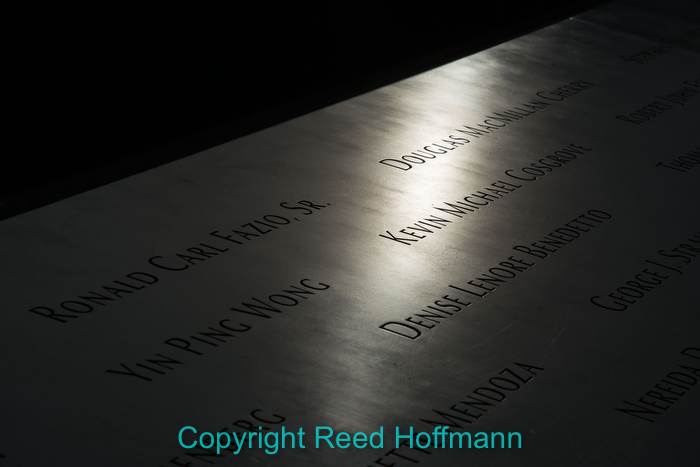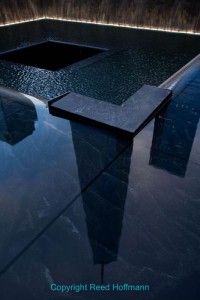I’m in New York City a couple of times a year. After the terrorist attacks in 2001 people would often ask if I ever visited Ground Zero. The answer was no. I didn’t want to. As a newspaper photographer, the assignments I dreaded most were those that involved personal tragedy. It was painful to see the raw emotions of the people left behind. That was the stuff that kept me up at night. And of course this was on a massive scale. If I didn’t have to go down there – and I didn’t – then I wasn’t going to. But I cared, and followed the progress of the plans for rebuilding and a memorial to honor those who died. So this past weekend, when I was in the city once again, I made a special trip to see what’s been done.
First off, let me say that the 9/11 Memorial is beautiful, in a simple, understated yet moving way. Where the two towers stood, in their exact footprint, are two huge reflecting pools with waterfalls cascading down all four sides. At the bottom, in the center of the pool, is a smaller square hole that the water disappears into. The railings surrounding the two pools have bronze tops with the names of all the people killed cut into them. Throughout the area are walkways, seating, grass and hundreds of trees. Nearby is the 9/11 Museum, and rising above it all is the new, nearly finished One World Trade Center, now the tallest building in the U.S.
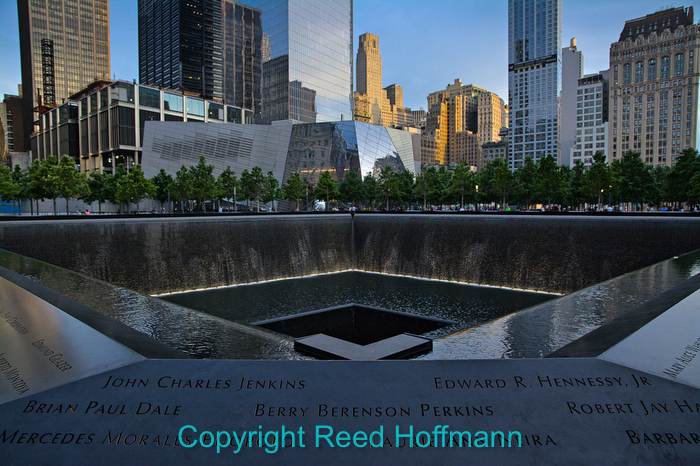
This was a five-frame HDR image, hand-held, to hold good detail in the darkest parts, like the names in the foreground, as well as the bright areas like the sunlight on the buildings in the background. Nikon D7100, Aperture Priority, ISO 400, 1/25 to 1/320 at f/5.6, Nikkor 16-85mm lens at 16mm. Photo copyright Reed Hoffmann.
The space gives off a feeling of hope, renewal and rebuilding. Of remembering, and honoring those who died. It was a time of uncertainty and fear in our country, which eventually brought us all closer together. The new memorial does a wonderful job of bringing all of that together.
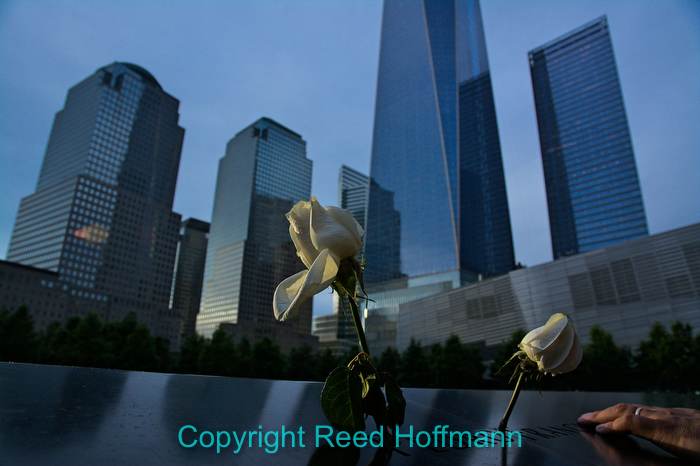
I placed my camera at the edge of this plate to put the roses, just catching the last light of the day, against the buildings behind. At first I was waiting for the person to remove his hand, and then realized it added a personal touch to the image. This is an HDR image, four different exposures combined into one photo, to keep detail in the panel and buildings as well as the flower. Nikon D7100, Aperture Priority, ISO 200, 1/1000 to 1/60 at f/7.1, EV -1.7, Nikkor 16-85mm lens at 16mm. Photo copyright Reed Hoffmann.
As a photographer, of course, I had a camera with me. One suggestion I make to students is to always make an effort to tell a story with their photos. In the two hours I spent there Sunday evening I walked and walked, looking for three types of photos. First, I needed pictures that gave a feel for the size and scope, where it was, what the area looked like. What we might call scene-setters, or overalls. Second, I needed some close-ups, details that would reveal more about the place itself and what was there. And third, some medium shots to tie the overalls and details together. Finally, when people are involved, it’s important to remember they’re part of that story too, and you need to find a way to incorporate them.
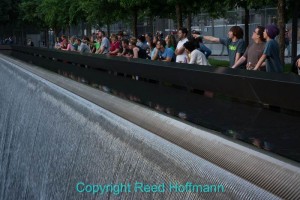
The design of the memorial is very people-friendly, inviting visitors to stay, explore and think about the events and losses of that tragic day.
Nikon D7100, Aperture Priority, ISO 250, 1/100 at f/5.6, EV -1.0, Nikkor 16-85mm lens at 48mm. Photo copyright Reed Hoffmann.
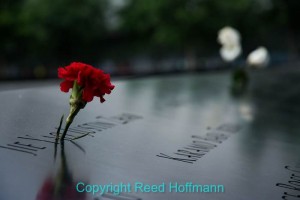
The bright color of this flower, in a mostly monochrome scene, makes it stand out. I emphasized that by shooting at a fairly wide aperture for shallow depth of field at a telephoto focal length.
Nikon D7100, Aperture Priority, ISO 200, 1/250 at f/5.6, EV -0.7, Nikkor 16-85mm lens at 85mm. Photo copyright Reed Hoffmann.
On a trip like this, where I was leading a seminar, not a shooting workshop (I was in the city to teach Nikon School), I don’t have much time to do photography. In that case I usually bring just one camera and a single lens. This time it was a Nikon D7100 and 16-85mm f/3.5-5.6. No other gear – no tripod, no filters, no flash or other lenses. So I wasn’t going to be able to shoot anything extremely wide or with much telephoto. But that was okay. In photography there are always limitations; the challenge is to make the most of what you’ve got.
It was a beautiful evening, temperature in the seventies, cloudy with a few shafts of light breaking through just before sunset. As the memorial closed for the evening and I walked back to the subway, I thought about how peaceful it was, and how different from that awful day in 2001, when for a time it seemed our world was ending. And how this memorial demonstrated the resilience of people, from death and destruction can come life and rebirth. That we won’t forget, but we won’t stop living, either. What more fitting way to honor those who died?
(If you have an opportunity to visit New York City in the future, I strongly recommend you stop by the memorial. You can find details about it here)
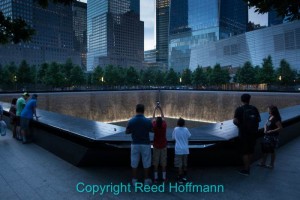
Not surprisingly, almost everyone took photos, whether with their cell phones or real cameras. As night fell the crowd thinned out, but that was when the light became best for photos.
Nikon D7100, Aperture Priority, ISO 400, 1/25 at f/5, EV -1.7, Nikkor 16-85mm lens at 16mm. Photo copyright Reed Hoffmann.

